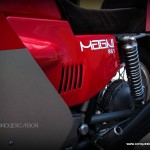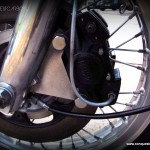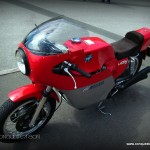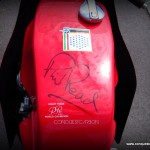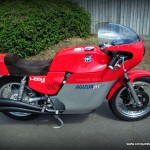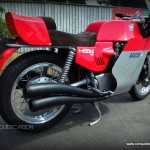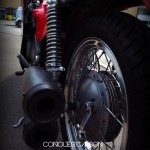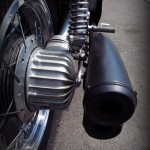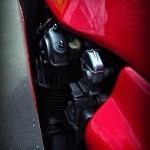1976 MV Agusta 750s America
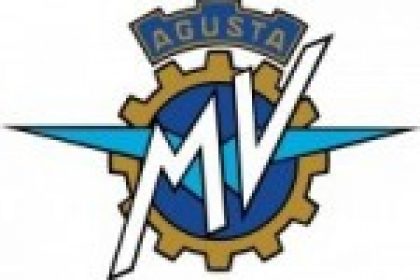
1976 MV Agusta 750s America
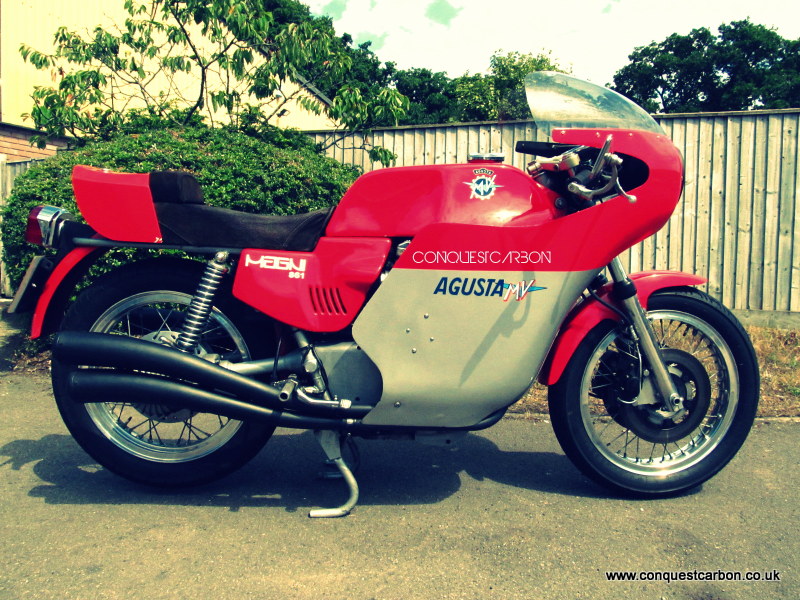
One owner from new, 1976 MVAgusta 750s America, owned by Mr George Daniels of the Isle of Man UK.
6500 geniuin unrestored condition………….stunning, thank to Steve Bateman.
Nothing about the new MV Agusta 7S0S America is understated Strong, visceral and bold, the bike overwhelms everything around it. This red-and-silver roadster becomes the indisputable center of attraction everywhere it deigns to appear. And the 750S America is overwhelming in other ways: it makes a conservative 75 horsepower, rushes through the standing quarter-mile in 13.06 seconds, passes the dragstrip timing lights at 105.14 mph. pulls like a truck from 2000 rpm, tips the decibel meter to 94 db(A). pierces its surroundings with an electrifying roar at 9000 rpm, runs tar beyond 130 mph In Mth gear, weighs a chunky 562 pounds wet—and costs a princely S6000. This cast-aluminum bank vault possesses a haughty aristocratic presence. Not vainglorious— the MV Agusta is just purely haughty.
Aristocratic or not. you ask—double-checking your wallet pocket—is the 750S America, or any motorcycle, worth S6000? The answer to that obvious question pivots on two considerations: first, the relative size of the pricelag as measured against an individual’s resources: and second, one’s expectations of what S6000 should buy in a motorcycle.
Machines such as the MV Agusta usually receive predictable reviews by the motorcycle press. Usually, hyper-expensive machines cause roadtesters to soar off into some loose jive-rapture about money/ego/motorcycles’ and the density of the paint. Or the opposite occurs. Testers screw on their hard noses, and push around comparisons like so many shmy pennies. Both approaches, flighty passion and penny-grinding comparisons, share at least one starting point: someone would buy a $6000 motorcycle on a $6000 motorcycle budget. But that assumption doesn’t truck much with reality. People who buy $6000 motorcycles operate on grandiose motorcycle budgets, and they don’t need passion as a justificatio dollar comparisons which quickly reach a point of diminishing relevancy in the real world of mega-buck motorcycle budgets.
So how should you approach a S6000 motorcycle? Simple. It starts with some hard facts of life. Motorcycles are toys for grown-ups. Six-thousand dollar motorcycles are toys for wealthy grown-ups. Because almost every motorcycle in the United States is a toy, no motorcycle is worth grievous, oppressive sacrifices to own. If you had to mortgage your grandmother’s silverware, or anything else, to buy an MV. it isn’t worth it. Most road-testers (and readers) couldn’t write a check for an MV without flinching, but the Rich of Motor Culture are different. They can. So first and foremost. MV Agustas are for those who can afford them—painlessly—and who agree with MV’s interpretation of what a $6000 motorcycle should be.
No matter how expensive, any motorcycle makes a series of trade-offs, such as speed for noise, or weight (or convenience. No ultimate be-all/end-all machine exists tor $6000 or any other price.
If you want a silent motorcycle that weighs under 500 pounds, winks back at you with eight warning lights and has built-in stereo, then regardless of your resources, buying a 750S America would be a dreadful waste of money—and a perfectly splendid MV Agusta.
The 750S America is powerful, quick-stopping, stylish, comfortable, fuss-free, and loud. It’s also quite heavy though it feels agile at legal speeds. The motorcycle handles well at normal paces, but it lacks outstanding handling at more energetic rates.
The things which the MV single-seater does best are the most easily perceived: appearance, acceleration, sound and speed. Everything has the look and feel of expensive quality, including the sand-cast done engine, the hand-hammered aluminum cold-air box. the suede saddle, hand and toot controls, and heavily chromed nuts and bolts. The MV engine, a magnificent piece of hardware, dominates the entire motorcycle The four-cylinder engine appears massive and brutal; but close-up, the individual components have an miricate, almost delicate character.
Belying its considerable weight, the 750S America makes a tight, compact package. The steel tank and seat have the same spare lines of MV s current Grand Prix bikes. Its styling gives the machine a tight, economical grace: nothing looks contrived or affected. The new roadster escaped the trendy angular styling of Giorgetto Giugiaro and his rectilinear pencil.
|
Make Model |
MV Agusta 750S America |
|
Year |
1975 |
|
Engine |
Air cooled, four stroke, transverse four cylinders, DOHC. 2 valves per cylinder. |
|
Capacity |
787.7 |
| Bore x Stroke | 65 x 56 mm |
| Compression Ratio | 10.2:1 |
|
Induction |
4x 26mm VHB Dell’Orto |
|
Ignition / Starting |
Battery and coil / electric |
|
Max Power |
75 hp @ 8500 rpm |
|
Max Torque |
|
|
Transmission / Drive |
5 Speed / shaft |
| 1st 11.68 / 2nd 8.45 / 3rd 6.47 4th 5.44 / 5th 4.98 | |
|
Front Suspension |
35mm Ceriani telescopic forks |
|
Rear Suspension |
Dual Marzocchi shocks preload adjustable |
|
Front Brakes |
2x 275mm discs |
|
Rear Brakes |
200mm drum |
|
Front Tyre |
90/90 -18 |
|
Rear Tyre |
100/90 -18 |
| 29 In. / 736 mm | |
|
Wet-weight |
562 lbs /252 9 kg |
|
Fuel Capacity |
19 Litres / 5.0 gal |
|
Consumption average |
12 km/lit |
|
Standing ¼ Mile |
13.9 sec |
|
Top Speed |
210 km/h |
Recently sold for £35,000.00
The sensual MV broadcasts the best sound trip in motorcycling. Through the dragstnp traps, things sound as if there’s a Grand Prix war in full progress. When the MV double-knocker peaks at 9000 rpm, you understand what the British press means by thai quaint transat-lantlcism. “full chat.”
The 750S America represents the king of machine which MV Agusta and Commerce Overseas Corporation believe an affluent American clientele will buy for S6000. To anyone who knows anything about motorcycle Grand Prix racing, MV Agusta is a self-explanatory concept. Commerce Overseas Corporation In New York, long associated with MV Agusta in the helicopter business, is the sole United States importer for MV motorcycles. Chris Garville from COC and Jim Cotherman. an MV retailer in the United States with credentials as a racer-tuner-developer, went to the MV factory in the fall of 1974 The American duo proposed a series of changes to update the existing 750 MV Agusta. The factory took their proposals under advisement and began work on a revamped roadster. Garville and Cotherman. working in concert with factory personnel, saw the new motorcycle, embodying their suggestions, literally take shape Contrary to the stereotyped Italian scenario, where tomorrow is always next year, the America project went forward rapidly. Inside fifty days, (he MV factory had a prototype rolling. The America project received important encouragement and support from Fredmano Spairani, an MV director. (Italophiles may remember Spairani as the corporate head of Oucati, when the Vee-twlns were launched and the 750 Desmos won the inaugural Imola 200.)
Power was a key consideration The MV four-cylinder responded well to prodding because it contained all the basic ingredients for great performance. Fundamentally, the engine is the old 500 Grand Prix unit which MV raced successfully irom the 1950s to the mid-1960s. When it first appeared in production form, the engine displaced 600ccs; later MV bumped it to 743cc. and now. in the America model, the capacity has gone to /88cc
Us growth has been carefully monitored and controlled. MV does not work on the American hot-rod principle, “hog it out and hope for the best.” MV precisely calculated the loads on all powur-traln components to guarantee reliability. And it paid off. At the dragstrip the MVS horsepower, weight, and tall first gear savagely abused the clutch, which withstood the brutality without slipping or protesting or even serving notice.
Some of the power increase has come from enlarging the pistons two millimeters (bore and stroke are now 67mm x 56mm); another increment was added by raising the compression ratio (from 10:1 to 10.2:1), but the greatest power gain lies in the cylinderhead
The cylinderhead has been recalibrated to deal with the increased displacement. The factory resisted the simple expedient of adding squish bands in the combustion chambers in order to cover the larger pistons. MV reflowed intake tracts. Installed larger intake and exhaust valves, and completely resphered the combustion chambers
Gone are the 24mm UBF Oell ‘Orto carburetors which fed the first 750 Sports In their stead are a quartet of 26mm VHP Dell ‘Ortos which, unlike the old set-up. have completely enclosed lops. The old derrick slide-litters are gone; the new MV has a single-cable race-type actuation mechanism
While the 788 engine uses more car-buretion than early 750s. the big engine actually has a milder camshaft, in terms of lilt and duration. The immensely tractable engine has power from 2000 rpm to 9000 rpm.
Machinery fascinates nearly all motorcyclists; some find whirring gears and shalts positively addictive. Hardware junkies blow themselves away on MV engines. It Is a masterpiece of precision castings, gears, needle bearings, ball bearings, shafts, and all other things in the hard goods department. Were it mass-produced, the engine would still be murderously expensive to buiW.
Item. A matched set of three straight-cut gears runs up between the interior cylinders; Ihis gear train, driven off the crankshaft, in turn drives the gears which turn the camshafts
Item: The pressed-together crankshaft turns on ball bearings (at each end) and lour enormous split-cage roller bearings at interior points. Unlike any other production engine in motorcycling, the crankshaft is held inside a separate cylinder-block casting, and this sub-assembly bolls into the main engine casting. This method of construction, a carry-over from MV racing engine design, gives the crankshaft incredibly strong support, minimizes thermal distortions, and eliminates the need tor mote complex and intricate casting/machining operations in a limited production engine Item Because the Bosch dynastan generator lies behind the engine sump, the mam engine cases are narrower than the cases ot a CB-400 Honda.
An itemized catalogue ot the MV engine’s lovely, arcane, sophisticated hardware might stretch on for twenty pages But the listing would be a cruel joke if this elaborate machinery only excelled at being elaborate. Or made no power. Or was fragile as brittle china.
The MV engine is rugged. It has that same run-on/run-on quality found in R90S BMWs and Honda 750s There’s every reason to believe that MV engines are set-it-and-forget-it propositions. Alter initial break-in (600 miles), the valve clearances can be set (010 and .012), and experience has shown that the valves will not normally require further ad|ust-ment for about 10,000 miles The Bosch distnoutor-type ignition is very automotive as is the Bosch starter /generator, and the drive-shaft eliminates any fussing with a chain Basic service intervals come round every 3600 miles The engine Itnl temperamental Our test bike would eventually wet-foul plugs because the carburetors had slides which produced extraordinarily rich mixtures Re-sliding for local conditions would have leaned out the mixture to normal.
Italian machines traditionally have been sported with ratty-tatty detailing Not so with the MV 750S America Italophiles will scarcely believe it. but Apnha has finally built real handlebar switches with casl aluminum bodies and plastic buttons The switches lollow the same pattern as Yamaha controls The 750 America shifts on the left side, and brakes on the right The switch has been done neatly inside the engine cases, so no Johnson-rod maze spoils the exlenor And at last MV Agustas have real air-filtration A beautiful hand-hammered aluminum cold-air-box houses a very simple dry synthetic fitter
The running gear changes have likewise been extensive between the old 750S and the America model. When Cycle last encountered the MV 750 Sport, the bike had a four-shoe front brake. That anchor has been replaced by double discs with Scarab calipers and master cylinder Our test MV has the best Scarab disc brake system which we’ve tried; lor feel and accuracy it’s almost in the same league as Lockheed components. The America model has a massive Cenani fork which replaces less formidable models on earlier MVs The heavy-duty Ceriani has 38mm lubes and wider, stronger triple clamps than previous equipment The frame, which retains the same 55-mch wheeibase and basic geometry, has a stronger steering neck.
MV made no changes m the driveshatt unit nor in the gear ratios-primary, transmission, and final The swing arm has been taken straight off old models, as have the Sebac rear dampers.
Our test America, which was literally the
first production bike built, varied from later bikes in three ways First, the instrument panel, a la Oucati. has been scrapped in favor ol the alloy instrument holders fitted to previous 750 Sport models. This substitution brings the ignition switch back between the instruments. Furthermore, gas taps will be activated by the ignition switch, as per Moto Guzzi. and the centerstand toe-down bar. which ground slightly, will be raised a bit.
Space relationships have been thoughtfully worked out on the MV 750S America Since the MVs suede saddle is firm, the roadster’s comfort grows out of the relative positioning of pegs, bars and seat Not only >s the saddle just 29 inches off the ground, it’s relatively low to the clip-ons-which have built-in risers Moreover, the tank isn’t excessively long The foot pegs have been positioned low enough so that the rider’s knees aren’t tucked into his armpits The loot controls intersect nicely with hands and feet; no awkward groping is necessary The controls operate with a velvet softness, and the engine contributes to the luxurious placidity. The engine vibrated less than a CB-750 but perhaps a bit more than a CB-550
Of course, the America can’t match the BMW R90S lor sheer luxurious comfort The MV is more restful than other genuine clip-on roadsters, namely the John Player Norton, the Ducati Sport and Super Sport, or the Laverda SFC. Although the saddle has far less padding than a Moto Guzzi Sport, a 275-mile jaunt revealed no great difference in riding fatigue between the MV and Guzzi
The Bosch starter-generator spins the engine silently With no preliminaries, the Italian four-cylinder whoofs into action, creating a mushroom cloud ot sound gear-meshing noise from the cylinder head chest balanced by the angry snarls from the lour mufflers. Nicking the throttle skyrockets the tach-needle and curls your ears The engine has no flywheel inertia, so instant throttle response is the engine’s middle name
With the standard exhaust system the rider can’t escape the noise. Most enthusiasts wouldn’t want to snuff out those intoxicating sounds. However. MV does manufacture a special exhaust system for the America, and the new plumbing, together with a fairing, will back off the volume to 84 db (A). Cycle staffers sampled the decibels-down mufflers for a half-hour, and then reverted to the more standard-music mufflers
Without question, the 750S America joins that small (and dwindling) coterie of high performance street motorcycles The dnvesha’t prevented any dynamometer testing; nevertheless, the dragslrip testing confirmed its strength Bearing in mind its quarter-mile handicaps (weight. 60-mph first gear. 140 mph fifth gear), the MV snapped through in 13.06 with a terminal velocity of 105.14. That’s really impressive since the MV gives away lots ot lime m the first 150 feet. Lighter motorcycles with larger engines geared more
appropriately for Ihe dragslrip (Laverda 1000 and Kawasaki Z-iB) will slop the clocks quicker and deliver slightly higher trap speeds (Laverda 1000. 1295 @ 106.13; Kawasaki Z-IB. 12 37 @ 107 36) But no matter what you own. don’t bother trying to outrun the 750 S America on Ihe top end. At 85 mph (where it just has cleared second gear), the MVs close-ratio gearbox and compact size works to its advantage The 750S America would slip away from Cycle Magazine’s favorite Z1 -8 (dyno-lesled at 83 horsepower) from 80 mph upwards. Though no suitable place exists to lest for meaningless top speed figures, our test bike was easily strong enough to climb well into the 130s
On board the MV certainly sounds brutish, bul no harshness feeds into the controls. The clutch lever has a soft draw and a wide, predictable engagement arc The gearbox shifts with the accuracy and leel of a bolt-action rifle When the throw of the left-side shifter pedal was tightened up. it duplicated the touch and feel of right-side shifting MVs. which do the best gear-changes of all street roadsters. The twistgnp has a soft return spring, burning off a long-time Italian wan
You needn’t be Superman to make the front tire moan The powerful dual discs system has no spongmess in it. Braking force goes up in a nice linear way. without demanding excessive muscle By comparison, the rear drum brake doesn’t exist. It feels almost powerless, and there’s not much feedback It’s the single control distinguished by vagueness and fuzziness.
The heavy-duty from discs are absolutely imperative, considering Ihe MVs 562-pound wet weight and the speeds at which the engine will propel this mass The MV outweighs the only other bikes of similar size and power The Laverda 1000 pushes Ihe scales to 520 pounds, down 40 on the MV. Kawasaki’s Z-IB comes m at 540 pounds, undercutting the MV by 20 pounds. Other dnveshaft motorcycles, the BMW R90S and Moto Guzzi Sport, are substantially lighter than the MV—70 pounds. The America’s compactness can fool you; it looks much lighter than il is. Pulling the bike on its center-stand (without knowing the Irick) al once suggests how heavy the MV is. Surprisingly, all the weight isn’t in the engine The complete unit, including starter-generator and carburetors, weighs jusi over 200 pounds. The MV carries a greal deal of unsprung weight, especially at Ihe rear, thanks to the dnveshaft system.
The choice of tires, lire combinations (m terms of fronl-to-back match) and rim widths makes an astonishing difference in cornering power (and the feel of that power) on any motorcycle. A so-called perfect combination for a given machine may only evolve after an extended period of trial and error. For some machines. >t never happens With a bike as heavy and powerful as Ihe MV, the choice and balance is critical. Our lest bike came equipped wiih a Metzeler 3.50 x 18 Rille rib on the front rim (2.16 inches beadhead width) and a 4.00 x 18 Metzeler C7 racing-block pattern on the rear rim (25 inches). With the front inflated to 28 psi and the rear 32 psi (cold readings), the MV would weave and snake treacherously in fast corners At those pressures, the handling produced bone-chilling fright in the rider Leaving the front tire alone and lowering the cold pressure in the rear lire to 26 psi produced a stable condition without causing tire overheating. Hot pressure in the rear tire checked out at 30 psi
Moderately hard cornering was then perfect on smooth bends, but a bump in a fast corner used up the rear suspension movement (even with full spring preload on the shocks) and a slow oscillation would result. The MV drifts through corners more than most motorcycles, especially lighter bikes. Aslow, controlled drift without oscillation means that a bike is able to use all the available tire adhesion without causing the frame to flex resonantly With the MV. there’s an awful lot of weight on the front wheel and much more development time needs to be spent on tire and wheel selection, as well as shock absorbers, for racing-speed conditions.
The MV doesn’t handle as well as a Laverda 1000. Compared to a competently prepared Kawasaki 2-1. the MV is taut and stable when the tires are inflated properly The Z-1 mushes around and cushes against its cornering limit The MV approaches its boundary more directly and without a lot of preliminary wiggles and loose-jomiedness. And at the limit the MV will corner at higher speeds without oscillation than tne Z-1.
Alternate SAW shock absorbers with stronger damping and heavier springs helped to control the MV’s wobble-reaction m bumps through fast corners But this stiffened the boulevard ride into harshness. Anyone who wants to push his MV 750S lo its limit should be prepared to experiment with tires, rims and shock absorbers—and he should be an accomplished, experienced rider because the MV, unlike the Laverda 1000 (but like the Z-1). is neither easy nor comfortable to nde really hard
Handling in terms Ol Steering-response feel is slow and heavy The MV can move you at such a bhnrjing pace that tne lack of flickery is reassuring. Decided and purposeful pressure must be applied to the appropriate handlebar, foolrest and tank side in order to change the MV’s attitude al great speed The mosl advantageous rider position from which to guide the MV’s path is a crouch m a constant upright stance without body lean relative to the bike it is difficult to change one’s body pressures accurately on a machine while hanging off to the pavement side.
Six-thousand dollar motorcycles don’t qualify as disposable, throw-away items So natural restraint and John Law. if nothing else, will keep MV riders away from hot-lick riding At ordinary speeds, the MV does handle welt enough, and produces no disconcerting quirks across bumps in smooth roads. The short wheel-base and small amounl of trail minimize the sense of weight. Compared to a Moto Guzzi Sport, the America responds more quickly to inputs al moderate speeds, though it’s 70 pounds heavier than the Guzzi Furthermore, there’s a tremendous horsepower differential.
Again and again the MV impresses a rider with its style, smoothness, comfort and-most of all-ils sheer power, which is accompanied by the ever-present MV music The 750S America is a grand bou-levardier suitable lo street parading, mountain-road stroking, and autostrada smoking Name any venue; the red-and-silver MV will be the star attracttorr
Exclusivdy comes at no extra cost At the very best. MV can build 200 America models in 1975. all of which will land in the United States. With this limited production motorcycle MV has finally made a commilment lo the American market. It’s almost ironic. At the same time MV ai last arrives, other high-performance European models are disappearing from the American scene. Moto Guzzi’s American efforts have been totally concentrated on the 850 T Farewell. 750 Guzzi Sport At least for 1975. and perhaps longer. Ducati Sporls and Super Sports Desmos cannot be imported into the United States. Both bikes are vicllms of right-hand shift legislation. And the factory, which can sell the entire production m Europe, sees no compelling reason to make a U.S. version Also the newest Laverda we’ve seen still has right-hand shift, until that can be changed, you won’t see Laverda 1000s here either. The BMW R90S. measured by Laverda-Ducali-MV standards, is a high-volume motorcycle, and fortunately the German twin won’t disappear But a distressing fact remains: those who like European interpretations of high-performance motorcycles may find their choices severely limited, or ihe options increasingly expensive
Given those realities, every MV America 750 which lands in the United States will be snatched up. An eager welcome may encourage MV to build even more sporting motorcycles in the future. MV Agusta has financial, technical and manufacturing resources to offer a continuing line of high-performance limited-production motorcycles. Exciting as the 750S America is today, we can hardly wait till tomorrow $
Source CYCLE 1974


